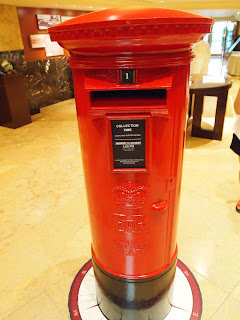Latest Articles
Sunday, March 10, 2013
Asian Civilizations Museum
Free-access Singapore River Interpretive Gallery on the 2nd Level. It traces the history of the Singapore River.
Q: How is the history of Singapore River portrayed in the gallery?
The gallery takes on a very everyday life approach. It describes and show the different aspects of life then.
Coolies smoking opium
Coolies having their meals
Opium equipment used
Currency used
Travel Documents
The gallery shows other aspects such as entertainment of the people living by the Singapore River. The exhibits includes traditional Chinese instruments such as the Er Hu. The gallery shows the importance of the Singapore River during that time as a center for assemblies as well as its economic importance. It also shows the vibrancy of the Singapore River during that time and how it has transformed over time to what it is now.
Singapore River
From Chettiars to Financiers
The Great Emporium
read more
Statue of Raffles at the spot where he is believed to have landed on 29th January 1819
Marble Carving introducing Raffles.
Q: Consider this open adulation of a colonizer. What kind of impact does it have on a nation's history?
It credits and glorifies colonization of the nation, hence it may make the nation's identity blurred. In Singapore's case, this glorification is justified taking into account how the colonization has eventually set the foundation for future development.
Group Photo! ^^
Cavenagh Bridge
 Named after the last Governor of Singapore. Built in 1869, it is the oldest bridge on the Singapore River to survive its original incarnation. The bridge was prefabricated in Glasgow, shipped to Singapore and reassembled on arrival by the Scottish firm P&W MacLellan. It was one of the last major public works to be built by convict labor from India.
Named after the last Governor of Singapore. Built in 1869, it is the oldest bridge on the Singapore River to survive its original incarnation. The bridge was prefabricated in Glasgow, shipped to Singapore and reassembled on arrival by the Scottish firm P&W MacLellan. It was one of the last major public works to be built by convict labor from India.
Q: Who was the bridge named after?
Cavenagh Bridge was named after Major-General (later Sir) William Orfeur Cavenagh, last Governor of Singapore (1859 - 1867) before it became a Crown Colony.
Q: Should the bridge be renamed after one of our local heroes?
No. It was after all built by the British and the style of the bridge is Western. It would be odd if it was renamed after a local hero of another ethnicity.
Q: There's a secret to the bridge. What is it?
The bridge is weak.
Police notice erected at both ends of the bridge.
Group Photo! :D
As we made our way to Cavenagh Bridge, we found, The Kucinta Cats!
read more
Qn: What
is the history of this building?
The Fullerton Building stands on a historical site which was once home to the Fullerton Fort and a small General Post Office.
Opened in 1928, the Fullerton Building was purpose-built to be the new General Post Office. Generations of postmen worked in the building till the General Post Office moved in 1996.
Today, this grand building continues to make history as The Fullerton Hotel Singapore.
Qn: What about Fullerton
Square?
Fullerton Square , on the left of the Fullerton Building, was a popular venue for political rallies during the Singapore's General Elections until 1988. They were usually held during lunchtime to draw the office crowds who worked in the nearby commercial district. Many braved rain and shine to gather at Fullerton Square to listen to the legendary speeches of then- Prime Minister Lee Kuan Yew.
read more
Created by Lim Nang Seng in 1972, the Merlion was a symbol representing Singapore. The fish in its design alludes to the idea of Singapore as a port city and its dependence on maritime trade, especially in the days of Temasek. The lion is a reference to a tale narrated in the Sejarah Melayu (Malay Annals), which describes how Malay king Sang Nila Utama reportedly encountered a lion when he first stepped on the shores of this island, leading him to rename Temasek Singapura ( “lion city” in Sanskrit).

The Esplanade
Esplanade, the premier centre for the Arts in Singapore, was built on October 2002.This centre was the crown jewel of our local government's efforts to make Singapore culturally successful and noteworthy.
The Esplanade defines
our local cultural space because it dictates and embodies certain artistic
standards and standards for selection and acceptance into the mainstream
locally.
This venue has since became one of Singapore's attraction and has helped to contribute to the social and national good. It creates a sense of community and belonging to Singaporeans and also the vibrancy of Singapore as an international arts city.
The Fullerton Waterboat House
Built by Hammer & Company in 1919, The Waterboat House supplies fresh water to incoming
ships. This historic landmark had been reinvented with a deep appreciation of its classical
architectural design.
Subscribe to:
Posts (Atom)











































